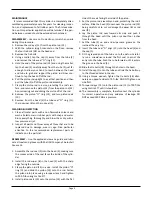
Page 2
MAINTENANCE
It
is
recommended
that
this
cylinder
be
completely
disas
‐
sembled
approximately
every
fi
ve
years
for
cleaning,
inspec
‐
on,
and
replacement
of
all
rubber
parts.
The
fi
rst
examina
‐
on
on
this
par cular
applica on
will
determine
if
the
peri
‐
od
between
service
should
be
extended
or
shortened.
DISASSEMBLY
–
Use
care
not
to
destroy
or
scratch
any
parts
during
this
procedure.
1.
Remove
the
rod
eye
(15)
from
the
piston
rod
(13).
2.
With
the
cylinder
lying
horizontal
on
the
fl
oor,
remove
the
four
e
bolts
(18)
on
the
head
end.
3.
Remove
the
e
bolts.
4.
Using
a
mallet,
tap
the
cap
(1)
away
from
the
tube
(2)
and
remove
the
tube
seal
“O”
ring
(11).
5.
Hold
the
end
of
the
piston
rod
(13)
and
using
the
mallet,
tap
the
head
(3)
carefully
away
from
the
tube
(2)
just
far
enough
to
allow
your
hand
to
reach
between
the
head
and
tube
to
grab
and
support
the
piston
rod.
Now
con
‐
nue
to
tap
the
head
o
ff
of
the
rod.
6.
Pull
the
piston
rod
upright
to
a
ver cal
posi on
and
then
pull
the
tube
(2)
o
ff
of
the
piston
rod
assembly.
7.
Clamp
the
piston
rod
in
a
vise,
protec ng
the
rod’s
sur
‐
face,
and
remove
the
piston
(14)
from
the
piston
rod
(13)
by
unscrewing
nut
and
sliding
the
piston
o
ff
of
the
rod.
8.
Remove
the
piston
“O”
ring
(12),
and
two
piston
seals
(10).
9.
Remove
from
the
head
(3)
the
tube
seal
“O”
ring
(11),
the
rod
wiper
(8)
and
the
rod
seal
(9).
CLEANING & INSPECTION
1.
Clean
all
metal
parts
with
a
non
‐
fl
ammable
solvent
and
wash
all
elastomer
or
rubber
parts
with
soap
and
water.
Rinse
everything
thoroughly
and
blow
them
dry
with
a
low
pressure
air
jet.
2.
Inspect
all
parts
and
throw
away
all
those
that
are
to
be
replaced
due
to
damage,
wear
or
age.
Give
par cular
a en on
to
the
recommended
replacement
parts
as
indicated
on
the
parts
list.
REASSEMBLY
–
Use
the
exploded
view
as
a
guide
and
lubri
‐
cate
all
seals
and
grooves
with
Shell
Oil
Company’s
Aeroshell
Grease
14.
1.
Assemble
the
rod
seal
(9)
into
the
head
(3),
making
sure
the
concave
side
of
the
seal
faces
the
inside
of
the
cylin
‐
der.
2.
Install
the
rod
wiper
(8)
in
the
head
(3)
with
the
sharp
edge
facing
the
outside.
3.
Clamp
the
piston
rod
(13)
in
a
vise,
install
the
piston
“O”
ring
(12)
and
slide
the
piston
(14)
onto
the
rod.
Fasten
the
piston
into
place
using
a
torque
wrench
and
ghten
to
500
‐
lbs
using
Loc te
277.
4.
Install
piston
seals
(10)
onto
the
piston
(14)
with
the
fl
at
side
of
the
seals
facing
the
inside
of
the
piston.
5.
Set
the
piston
rod
assembly
on
end,
protec ng
the
rod’s
surface.
Slide
the
head
(3)
down
over
the
piston
rod
(13)
being
careful
not
to
cut
or
damage
the
wiper
(8)
or
rod
seal
(9).
6.
Lay
the
piston
rod
over
towards
its
side
and
push
it
through
the
head
un l
the
piston
is
about
four
inches
from
the
head.
7.
Set
the
tube
(2)
on
end
and
wipe
some
grease
on
the
inside
at
the
very
top.
8.
Insert
the
tube
seal
“O”
rings
(11)
into
the
head
(3)
and
the
cap
(1).
9.
Fit
the
greased
end
of
the
tube
on
to
the
piston.
Careful
‐
ly
run
a
screwdriver
around
the
fi
rst
seal
to
assist
the
entry
into
the
tube.
Push
the
tube
forward
un l
it
enters
the
groove
in
the
head
(3).
10.
Slide
the
e
bolts
(18)
through
the
holes
in
the
head.
11.
Install
the
cap
(1)
onto
the
tube
and
slide
the
e
bolts
up
to
the
threaded
holes
in
the
cap.
12.
Using
a
torque
wrench,
ghten
the
e
bolts
(18)
alter
‐
nately
on
opposite
sides
to
70
‐
lbs.
DO
NOT
ghten
one
side
fi
rst.
13.
Torque
rod
eye
(15)
onto
the
piston
rod
(13)
to
700
‐
lbs
using
Loc te
277
un l
it
shoulders.
14.
The
reassembly
is
complete,
therefore
test
the
cylinder
for
correct
opera on
and
any
evidence
of
leakage.
DO
NOT
exceed
150
PSIG
air
pressure.








